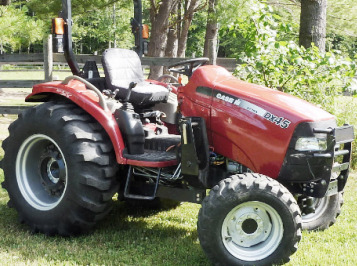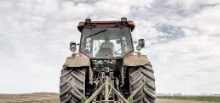________________________________________________________________________________________
| Home / Farm Tractors / Case IH Tractors / Case IH DX45 |
Case IH DX45 Troubleshooting
 The
Case IH DX45 is a 4WD compact utility tractor. This model was manufactured from
2001 to 2006. The components of Case IH DX45 powerline system: a 135.2 cubic
inches (2.2 L) Shibaura N844L 4-cylinder liquid-cooled diesel engine with a
rated power of 45 hp (33.6 kW), and two-range hydrostatic transmission with
infinite forward and reverse gears.
The
Case IH DX45 is a 4WD compact utility tractor. This model was manufactured from
2001 to 2006. The components of Case IH DX45 powerline system: a 135.2 cubic
inches (2.2 L) Shibaura N844L 4-cylinder liquid-cooled diesel engine with a
rated power of 45 hp (33.6 kW), and two-range hydrostatic transmission with
infinite forward and reverse gears.
The maximum travel speed (forward/reverse): 13.6 mph (21.9 km/h). The open center hydraulic system includes an implement pump with rated fluid flow of 9.8 gal/min (37.1 l/min) and steering pump with rated fluid flow of 5.1 gal/min (19.3 l/min). The Case IH DX45 is equipped with a hydrostatic power steering system, wet disc brakes, 8.00x16 or 27x8.50-15 front tyres, and 14.9x24 or 44x18.0-20 rear tyres.
The wheelbase is 73.5 in (1860 mm). The tractor is compatible with a 84" mid-mount 4-blade Case IH MWX84R mower deck with cutting height of 2.0-4.0 in (51-102 mm), and Case IH L160 loader with lift capacity to full height of 2000 lbs (907 kg).
| Engine Troubleshooting |
| Engine starts up hard or won't start |
Air in the fuel lines - Bleed the fuel lines.
Dirty fuel filter - Clean the filter element.
Fuel injection nozzles are clogged or faulty - Install a new kit of correctly balanced nozzles.
Dirt or water in fuel system - Drain water or flush dirt from the system.
Valve clearance is wrong - Adjust to proper valve clearance.
Damaged fuel injection pump - Replace injection pump or repair it.
| Engine starts but then stalls |
Air filter plugged - Clean or change the filter.
Clogged fuel filter - Clean or replace the filter.
Fuel injection pump is leaking - Repair any leaks.
Clogged or defective injectors - Clean or replace fuel injectors.
Fuel injection pump failure - Rebuild or replace pump.
| Engine shuts off suddenly while running |
Engine is not preheated - Normalize the temperature by warming up the engine.
Clogged fuel filter - Change filter element.
Air in fuel system - Bleed fuel system.
Fuel injection nozzles are clogged or faulty - Replace injection nozzles.
Improper setting of fuel injection pump timing - Use the correct fuel injection pump timing adjustment.
| Engine shuts off while idling |
Incorrectly set low idle speed - Need to adjust idle speed.
Fuel injection pump is not working correctly - Replacement or repair required.
Defective fuel injectors - Clean fuel injectors or change it.
Incorrect valve clearance - Check and adjust as required.
| Reduced engine power |
Air filter is dirty - Air filter maintenance required.
Defective or clogged injection nozzle - Check and replace nozzles if required.
Uneven fuel injection pressure - Adjust pressure to proper level.
The valve clearance is incorrect - Correct valve clearance needs to be set.
Incorrectly set low idle speed - Need to adjust idle speed.
Fuel hoses or lines clogging - Fuel lines and hoses need to be cleaned.
Cylinder head gasket is damaged - Replace cylinder head gasket.
Piston rings are damaged or leaking - Piston rings need to be replaced.
| Engine overheating |
Engine coolant is insufficient - Refill to the correct level and inspect system for leaks.
Insufficient engine oil - Need to add engine oil.
Faulty radiator cap or dirty radiator fins - Change cap or clean radiator.
Broken or loose fan belt - Change as required.
Engine overloaded - Load reducing is recommended.
| Low oil pressure |
Low crankcase oil level - Fill crankcase to proper oil level.
Oil filter element clogged - Replace or service engine oil filter.
Incorrect oil viscosity - Use oil of correct viscosity.
Incorrect oil clearance in main bearing - Bearing needs to be changed.
Oil pump is defective - Install a new pump.
| Engine noises or knocks |
Low engine oil level - Checking oil level and add if necessary.
Engine is not warmed up to the required temperature - Engine is not warmed up to the required temperature.
Fuel injection pump timing is not adjusted - Adjust as recommended.
Low idle speed set incorrectly - Adjust as required.
Damaged or clogged injectors - Replace fuel injectors.
Connecting rod is defective or misaligned - Align or change connecting rod.
Pistons are worn or broken - Have pistons replaced.
| Hydrostatic Transmission Troubleshooting |
| Hydrostatic transmission noise |
Transmission oil is contaminated or oil level is insufficient - Fill to required level or change the transmission oil.
Speed control pedal linkage is damaged or out of adjustment - Adjust or repair linkage.
Stuck relief valve - Install a new valve.
Transmission is under excessive load - Load needs to be reduced.
Worn or defective parts of the hydrostatic transmission - Change or repair defective parts.
| Power is too low |
Low oil level - Fill the transmission housing with oil.
Relief valve failure - Replace relief valve.
Worn or out of adjustment speed control linkage - Adjust or change linkage.
| Transmission oil overheats |
Low oil level - Fill the transmission housing with oil.
Plugged transmission oil filter - Clean or change transmission oil filter.
Cooling components are defective or plugged - Check all cooling components and repair or change if required.
Transmission is under excessive load - Reduce loading.
| External fluid leaks |
Seals or gaskets are broken - Gaskets or seal replacement required.
Transmission case internal pressure is too high - Replace worn components.
Plugged transmission fluid return tube - Service or replace return tube.
| Hydraulic System Troubleshooting |
| Low hydraulic fluid pressure |
Hydraulic fluid is insufficient - Fill the system to proper hydraulic fluid level.
Dirty hydraulic fluid filter - Service the hydraulic filter or change if required.
Faulty hydraulic pump - Replace or repair hydraulic fluid pump.
Hydraulic control valve is not set properly - Adjust properly.
Hydraulic cylinder is faulty - Install a new hydraulic cylinder or repair it.
Leaks in hydraulic lines - Check the system and repair leaks.
| Hydraulic system overheated |
Faulty main relief valve - Install a new relief valve.
Hydraulic fluid type is incorrect - Pour the correct type of fluid.
Hydraulic oil is contaminated - Fill up with fresh hydraulic oil.
Air in the hydraulic system - Air bleeding.
| 3-point hitch won't lift or lifts slowly |
Hitch is under excessive load - Reduce loading.
Hydraulic oil level low - Checking hydraulic oil level and add if necessary.
Dirty hydraulic fluid filter - Clean the hydraulic filter or install new filter element.
Hydraulic pump not working - Replace or repair hydraulic fluid pump.
Defective main relief valve - Replace relief valve.
Hydraulic spool valve is damaged - Change or repair hydraulic valve.
Hydraulic cylinder is broken - Replace or repair hydraulic cylinder.
Loose or broken suction line - Tighten the pipe or replace it.
| 3-point hitch cannot be lowered or lowering is too slowly |
Hydraulic control valve block is set improperly - Set properly.
Hydraulic cylinder not working - Replace or repair hydraulic cylinder.
3-point hitch is out of adjustment - Adjust the hitch.
Hitch cross shaft is damaged - Change the shaft.
| Hitch drop or lift is jerky |
There is air in the hydraulic system - Bleed hydraulic system.
Contaminated hydraulic oil - Change hydraulic oil.
Hydraulic pump is defective - Install a new hydraulic fluid pump.
Faulty hydraulic spool valve - Repair or change hydraulic valve.
Hydraulic cylinder is faulty - Install a new hydraulic cylinder or repair it.
| Steering Troubleshooting |
| Difficult steering |
Worn or incorrectly fitted steering column - Replace the steering column or refit it correctly.
Air in steering system - Air-bleed steering system.
Not adjusted toe-in - Adjust toe-in properly.
Tire pressure is uneven - Adjust the tire pressure.
Hydraulic steering pump is defective - Repair or change steering pump.
Stuck or damaged steering pump control valve - Clean or replace control valve.
Insufficient steering fluid - Fill up the steering fluid.
| Steering wheel free play is excessive |
Steering column shaft or coupling is worn out - Change defective part.
Defective hydraulic steering pump - Install a new hydraulic steering pump.
Worn or loose steering linkage assembly - Change or repair steering linkage.
| Front wheels wander to left or right |
Uneven tyre pressure - Inflate the tyres properly.
Incorrect toe-in - Check toe-in and correct.
Worn or loose steering linkage joints - Replace or repair steering linkage.
Front wheel bearings are damaged or incorrectly adjusted - Replace or adjust the bearings correctly.
| Electrical Troubleshooting |
| Battery does not charge |
Loose or corroded electrical wiring connections - Tighten or service connections.
Battery terminal connectors are faulty - Change terminal connectors.
Battery failing - Battery change required.
Defective or loose belt - Change belt or adjust belt tension.
| Starter motor turns slow |
Battery voltage is low - Battery is drained, charge it.
Battery won’t hold charge - Service charging system or change battery.
Disconnected wires or corroded battery terminals - Check cable connections and change or clean terminals.
| Starter does not work |
Battery is drained or worn - Change or recharge battery.
Battery wiring is disconnected or improperly connected - Inspect wiring and connect as required.
Low battery power - Low battery charging, charge as required.
Defective starter motor - Repair or replace starter.
________________________________________________________________________________________
________________________________________________________________________________________
| Farm Tractors Technical Specifications |
